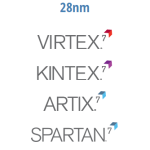Designing with the 7 Series Families
Course Description
Are you interested in learning how to effectively utilize 7 series architectural resources? This course supports both experienced and less experienced FPGA designers who have already completed the Designing FPGAs Using the Vivado Design Suite 1 course. This course focuses on understanding as well as how to properly design for the primary resources found in this popular device family.
Topics covered include device overviews, CLB construction, MMCM and PLL clocking resources, global, regional and I/O clocking techniques, memory, FIFO resources, DSP, and source-synchronous resources. Memory controller support and the dedicated hardware resources available in each of the families (PCI Express® technology, analog to digital converters and gigabit transceivers) are also introduced.
This course also includes a detailed discussion about proper HDL coding techniques that enables designers to avoid common mistakes and get the most out of their FPGA. A combination of modules and labs allow for practical hands-on application of the principles taught.
Level
FPGA 3
Training Duration
2 days
Audience
For those who have taken the Essentials of FPGA Design course
Prerequisites
- Designing FPGAs Using the Vivado Design Suite 1 course
- Intermediate VHDL or Verilog knowledge
Software Tool
- Vivado® Design or System Edition 2016.3
Hardware
- Architecture: Spartan®-7, Artix®-7, Kintex®-7, and Virtex®-7 FPGAs
- Demo board: None
* This course focuses on the 7 series FPGA architectures. Check with your local Authorized Training Provider for the specifics of the in-class lab board or other customizations.
Skilles Gained
After completing this comprehensive training, you will have the necessary skills to:
- Describe all the functionality of the 6-input LUT and the CLB construction of the 7 series FPGAs
- Specify the CLB resources and the available slice configurations for the 7 series FPGAs
- Define the block RAM, FIFO, and DSP resources available for the 7 series FPGAs
- Properly design for the I/O block and SERDES resources
- Identify the MMCM, PLL, and clock routing resources included with these families
- Identify the hard resources available for implementing high performance DDR3 physical layer interfaces
- Describe the additional dedicated hardware for all the 7 series family members
- Properly code your HDL to get the most out of the 7 series FPGAs
Course Outline
Day 1
- 7 Series FPGA Overview
- CLB Architecture
- Slice Flip-Flops
- Lab 1: CLB Resources
- Memory Resources
- Lab 2: Memory Resources
- DSP Resources
- Lab 3: DSP Resources
Day 2
- I/O Resources
- Lab 4: I/O Resources
- Clocking Resources
- Lab 5: Clocking Resources
- Memory Controllers
- Dedicated Hardware
- Coding Techniques
Lab Descriptions
- Lab 1: CLB Resources – Synthesize a 32-bit incrementer with terminal count logic and pipelining registers. Verify that the appropriate resources were used with the Device and Schematic viewers included with the Vivado Design Suite. Use the Schematic Viewer to inspect the implemented results.
- Lab 2: Memory Resources – Complete the RTL code required to infer a dual-ported block RAM. Explore the design using the Schematic viewer. As an optional step, change the RTL code to infer a WRITE_FIRST block RAM.
- Lab 3: DSP Resources – Synthesize and implement a 24×17 MAC. Device usage will be verified via the Schematic viewer. As an optional step, using the IP Catalog, construct, instantiate, and implement a wide pipelined multiplier. Verify the results with the Schematic viewer.
- Lab 4: I/O Resources – Using the SelectIO Interface Wizard from the IP Catalog, construct a high-speed, clock-forwarded output interface. Explore through simulation the behavior of the various blocks. Also use the Schematic viewer to explore the physical resources of the 7 series FPGA tile used for construction of the high-speed output interface.
- Lab 5: Clocking Resources – Using the Clocking Wizard, build and optimize the appropriate MMCM and clock routing resources. Also instantiate these resources into the design. After the design is implemented, verify hardware usage with the Schematic viewer and explore other aspects of the silicon layout.

Datum
05 februari 2018 - 06 februari 2018
Locatie
Core|Vision
Cereslaan 24
5384 VT
Heesch
Prijs
€ 0,00
of
18 Xilinx Training Credits
Informatie
Training brochure
Registratieformulier
Registratie op aanvraag, neem contact op met ons.

